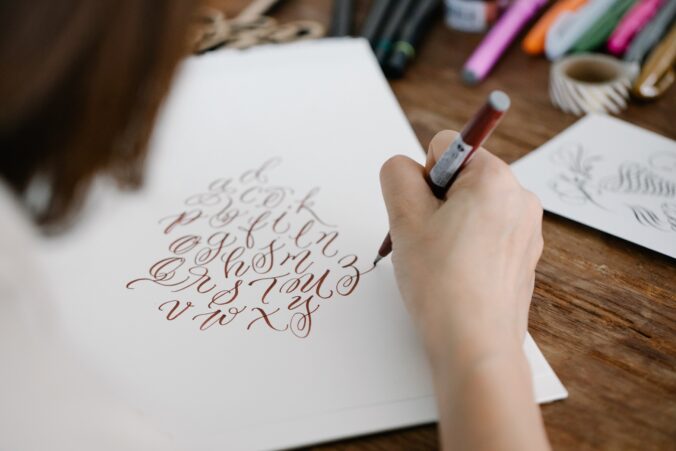Typography is a vital element in logo design and brand identity. The choice of font styles and sizes can significantly impact how your brand is perceived and how your message is conveyed. It is essential to carefully consider typography to align with your brand’s image, ensure readability across various mediums, and maintain scalability. In this article, we will explore the importance of typography in creating a cohesive brand identity, discuss font styles and sizes that resonate with your brand, and highlight the significance of readability and scalability.
- Reflecting Brand Personality and Image : Typography plays a pivotal role in reflecting your brand’s personality and image. Different font styles evoke distinct emotions and perceptions. A bold and modern font may convey strength and innovation, while a script font can evoke elegance and sophistication. It is crucial to select font styles that align with your brand’s core values, target audience, and industry.
Consider the personality traits and desired brand image. Is your brand youthful and energetic, or traditional and trustworthy? Choose fonts that reinforce these characteristics and create a harmonious visual representation of your brand.
- Establishing Readability : Readability is essential for effective communication. Regardless of the font style you choose, it is crucial to ensure that your text remains legible across various platforms and sizes.
Opt for fonts with clear and distinguishable letterforms. Avoid overly decorative or intricate fonts that may hinder readability, especially at smaller sizes or on digital screens. Test your chosen font styles in different sizes and mediums to ensure that they maintain their readability and do not compromise the clarity of your brand message.
Consider the contrast between your font and background color to enhance legibility. Ensure that there is enough contrast to make the text easily readable, particularly for those with visual impairments.
- Scalability for Versatility: Scalability is a key consideration in typography. Your logo and brand elements will be used across various mediums, from digital platforms to print materials. It is crucial to select fonts that scale well without losing legibility or visual impact.
Choose fonts that retain their integrity and clarity when scaled down or enlarged. Fonts with well-defined letterforms and balanced proportions tend to maintain their readability and visual appeal across different sizes.
Consider how your typography will appear on different surfaces and materials. Test its scalability by resizing your logo or text to different dimensions and assessing its legibility and overall aesthetic. This will ensure that your brand remains consistent and recognizable across various applications.
- Consistency and Hierarchy : Consistency in typography is paramount for a cohesive brand identity. Establish a set of guidelines for font usage, including font styles, sizes, and hierarchy, to maintain visual consistency across all brand touchpoints.
Create a typographic hierarchy that guides the viewer’s attention and organizes information effectively. Assign different font styles and sizes for headings, subheadings, and body text to establish a clear visual hierarchy. This hierarchy enhances readability and guides the audience through your content.
Consistent typography reinforces brand recognition and strengthens brand identity. By adhering to established guidelines, you create a cohesive and professional visual experience that builds trust and familiarity with your audience.
- Testing and Adaptability : Before finalizing your typography choices, conduct thorough testing to ensure their effectiveness and adaptability. Test your fonts across different mediums, including digital screens, print materials, and various sizes, to verify their readability and visual impact.
Gather feedback from different stakeholders, including designers, marketers, and target audience members. Their insights can provide valuable perspectives on the legibility and overall impression of your chosen typography.
Be open to adjustments based on feedback and testing results. Fine-tune font sizes, spacing, and even consider alternative font styles that better align with your brand’s image and improve readability.
Additionally, consider the adaptability of your typography. As your brand evolves and expands, your typography needs to be flexible enough to accommodate new applications and mediums. Ensure that your chosen fonts can be easily integrated into different design elements without losing their impact or readability.
- Pairing Fonts for Visual Harmony : Typography is not just about selecting a single font style; it also involves the art of pairing fonts for visual harmony. Combining complementary fonts can create a dynamic and engaging visual experience while maintaining readability.
When pairing fonts, consider contrast and balance. Choose fonts that have contrasting characteristics, such as pairing a serif font with a sans-serif font. This contrast helps establish a clear distinction between different sections of content or hierarchy levels.
Experiment with font combinations to find the right balance. Test different combinations, such as pairing a bold headline font with a more subdued body font, or mixing a script font with a clean and modern sans-serif font. Aim for a harmonious and cohesive overall composition that reinforces your brand’s personality and image.
- Evolving with Design Trends and Brand Growth : Typography, like all design elements, is subject to evolving trends. Stay updated with current design trends to ensure that your typography remains relevant and resonates with your target audience. However, be cautious not to chase trends blindly; always consider their alignment with your brand’s image and message.
As your brand grows and expands, periodic reassessment of your typography may be necessary. Analyze how well your chosen fonts align with your evolving brand identity and audience preferences. Adapt and refine your typography to maintain a strong and consistent brand presence.
Typography is a crucial element in creating a cohesive and impactful brand identity. By carefully selecting font styles and sizes that align with your brand’s image, ensuring readability and scalability, and incorporating visual harmony, you can effectively communicate your brand’s message. Consistency in typography across various platforms and applications strengthens brand recognition, while adaptability allows for future growth and expansion. Embrace the art of typography as a powerful tool to create a memorable and engaging visual experience that captures the essence of your brand.
